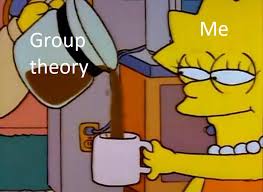Three Sylow Theorems - Application 1
2020-2학기, 대학에서 ‘현대대수1’ 수업을 듣고 공부한 바를 정리한 글입니다. 지적은 언제나 환영입니다 :)
Three Sylow Theorem은 이곳에서 확인할 수 있다.
Example.
A group of order 15 is not simple.
여기서의 ‘simple’은 위수 15를 갖는 군의 normal subgroup이 오직 trivial subgroup만을 갖는다는 말이다. 1
Sol.
$15 = 5 \times 3$
Let $P_3$, $P_5$ be Sylow 3-subgroup & Sylow 5-subgroup.
We claim that either $P_3$ or $P_5$ is normal to $G$.
(proof by contradiction)
Supp. both $P_3$ and $P_5$ are not normal to $G$.
$P_5$에 대해서 먼저 살펴보자.
먼저 1st Sylow Thm에 의해 $G$는 위수가 5인 subgroup을 적어도 하나를 가진다.
그리고 3rd Sylow Thm에 의해 (# of 5-subgroup)은 mod 5에서 1과 합동이다.
따라서 (# of 5-subgroup)는 1 도는 6 또는 11이다.
이들 중, 1만이 15를 나눌 수 있으므로 $G$는 위수가 5인 단 하나의 5-subgroup을 갖는다. (3rd Sylow Thm)
그러나 만약 $P_5$이 단 하나만 존재한다면, 2nd Sylow Thm에 의해 이것은 $P_5$가 normal subgroup임을 의미한다.
$p$가 동일한 두 Sylow $p$-subgroup $P_5$, $P_5’$에 대해 둘은 conjugate 관계이다.
이때, $G$에 대한 inner auto-morphism을 생각해보자.
그럼 For $g \in G$에 대해 $\sigma_g(x) = gxg^{-1} \quad (\forall g \in G)$로 homo-morphism이 정의된다.
이때, $P_5$를 $\sigma_g$에 태우게 되어 얻는 $\sigma_g (P_5)$는 2nd Sylow Thm에 의해 여전히 Sylow 5-subgroup이다.
모든 $g \in G$에 대해 $\sigma_g$를 구해 $P_5$를 태워도 여전히 $P_5$라는 결과를 얻는다.
따라서 $P_5$는 normal subgroup이다!
마찬가지의 방법으로 $P_3$에 대해서도 해볼 수 있다.
3rd Sylow Thm에 의해 (# of 3-subgroup)은 1, 4, 7, 11, 14이다. 이중에 15를 나누는 것은 1 뿐이다.
따라서 $G$에서 $P_3$는 단 하나 뿐이다. 따라서 $P_3$는 normal subgroup이다.
따라서 “both $P_3$ and $P_5$ are not normal to $G$.”라는 명제는 거짓이다!!
“either $P_3$ or $P_5$ is normal to $G$.”가 올바른 표현이다.
따라서 $G$는 trivial subgroup 외에도 다른 normal subgroup을 갖는다!! $\blacksquare$
Lemma 37.5
Lemma.
Let $H, K \trianglelefteq G$.
Supp. $H \cap K = \{ e \}$, and $H \lor K = G$.
Then, $H \times K \cong G$.
proof.
먼저 $hk = kh$임을 보이자.
\[\begin{aligned} hk(kh)^{-1} &= hkh^{-1}k^{-1} \\ &= (hkh^{-1})k^{-1} \in K \\ &= h(kh^{-1}k^{-1}) \in H \end{aligned}\]따라서 $hk(kh)^{-1} \in H \cap K$이다.
이때, 조건에서 $H \cap K = \{ e \}$라고 했으므로
$hk(kh)^{-1} = e$이고, 따라서 $hk = kh$이다.
$H \times K \cong G$를 보이기 위해 homomoprhism $\phi$를 하나 정의하자.
\[\begin{aligned} \phi: H \times K &\longrightarrow G \\ (h, k) &\longmapsto hk \end{aligned}\]그러면, $\phi$에 대해 아래가 성립하므로
\[\begin{aligned} \phi((h, k)(h', k')) &= \phi(hh', kk') \\ &= hh'kk' = h(h'k)k' \\ &= hkh'k' \\ &= \phi(h, k)\phi(h', k') \end{aligned}\]$\phi$는 homomorphism이다.
이제 $\phi$의 kernel에 대해 생각해보자.
만약 $\phi(h, k) = e$라면, $hk = e$인 원소가 $\ker \phi$에 속할 것이다.
이때, $h = k^{-1}$이므로 $h = k^{-1} \in H \cap K$이다. 따라서 $h = k^{-1} = e$이다.
따라서 $\ker \phi = \{ (e, e) \}$ 하나 뿐이므로, $\phi$는 1-1이다.
조건에서 $H \trianglelefteq G$라고 했으므로 $H \lor K = HK$가 된다. (by Lemma 34.4 & join)
또, 가정에서 $H \lor K = G$라고 했으므로, $H \lor K = HK = G$가 된다.
따라서 $\phi$의 이미지인 $\phi[H \times K] = HK$가 곧 $G$ 전체가 된다.
따라서 $\phi$는 onto이다.
$\phi$가 homo-, 1-1 & onto이므로 $\phi$는 isomorphism이다.
따라서 $H \times K \cong G$이다!
이 명제가 Lemma인 이유는 아무래도 Isomoprhism 파트에서 다뤘던 Lemma 34.4로부터 쉽게 유도할 수 있기 때문인 것 같다.
또 원래 목표인 $H \times K \cong G$는 사실 $H \times K \cong G = H \lor K = HK$이므로 사실상 $H \times K \cong HK$임을 보이는 명제였다.
Theorem.
Let $p$ be a prime,
then every group $G$ of order $p^2$ is abelian.
proof.
$G$가 cyclic이면 당연히 가환이므로, $G$가 cyclic group이 아니라고 가정하자.
그리고 1st Sylow Thm에 의해 $G$에는 $1, p, p^2$의 위수를 갖는 subgroup이 존재한다.
Let $a$ be an elt of $G$ of order $p$. (Cauchy의 정리에 의해 존재성이 보장)
그러면,
\[\left<a\right> = \{ e, a, a^2, \dots, a^{p-1} \} < G\]$b \in G \; \setminus \left<a\right>$인 원소를 생각해보자.
두 원소 $a$, $b$로 만든 순환군 $\left<a\right>$, $\left<b\right>$를 생각해보자.
이때, $\left<a\right> \cap \left<b\right> = \{ e \}$여야 한다.
만약 $c \ne e \in \left<a\right> \cap \left<b\right>$라면, $c$로 $\left<a\right>$도 생성할 수 있고, $\left<b\right>$도 생성할 수 있으므로 $\left<a\right> = \left<b\right>$가 된다. 이것은 $b \notin \left<a\right>$에 모순이다.
1st Sylow Thm의 두번째 진술에 의해 $\left<a\right>$는 위수 $p^2$을 갖는 $G$의 subgroup에 대해 normal subgroup이다. 이때, $G$에선 $G$ 만이 위수 $p^2$를 가지므로 $\left<a\right> \trianglerighteq G$이다.
마찬가지로 $\left<b\right>$ 역시 $G$에 normal subgroup이다.
이번에는 $\left<a\right> \lor \left<b\right>$를 생각해보자.
$\left<a\right> \lor \left<b\right>$에서 $\left<a\right>$는 proper subgroup이다.
즉, $\left<a\right> \subset \left<a\right> \lor \left<b\right>$이다.
이때, $\left<a\right>$의 위수가 $p$이므로 $\left<a\right> \lor \left<b\right>$의 위수는 $p^2$이어야 한다. 따라서 $\left<a\right> \lor \left<b\right> = G$이다.
우리가 위수 $p^2$인 $G$에서 얻은 사실을 정리하면 아래와 같다.
- $\left<a\right>, \left<b\right> \trianglerighteq G$
- $\left<a\right> \cap \left<b\right> = \{ e \}$
- $\left<a\right> \lor \left<b\right> = G$
따라서 앞서 살펴본 Lemma에 따르면
$G \cong \left<a\right> \times \left<b\right> \cong \mathbb{Z}_p \times \mathbb{Z}_p$이다.
즉, $G$가 두 cyclic group의 direct produce와 동형이므로 $G$는 가환군이다!! $\blacksquare$

아직 Sylow Theorem에 대한 Application이 더 남았다…
Sylow Theorem - Application 2에서 확인하자.
-
index 2를 갖는 simple subgroup과 헷갈리지 말자! ↩
